Facebook Live vs. Stories: When and Why to Choose?
Both Facebook Live and Stories can be effective, depending on goals and audience behavior. Live suits real-time interaction, longer-form demonstrations, and moments that benefit from Q&A and immediacy, while Stories fit quick, ephemeral updates that build lightweight, frequent touchpoints. Choose Live when depth and engagement matter; choose Stories for timely highlights and sequence-based snippets. Align format with audience expectations and content cadence for a smarter, more tailored strategy.
The Strategic Power of Format: Live vs. Stories
Deciding whether to use Facebook Live or Stories is really more about thinking through how you want people to experience what you share. Both options have their place, but the way they invite people in is different.
With Facebook Live, you’re right there with your audience as things happen – you see comments and questions pop up and can address them right away, which can make the whole thing feel more responsive and personal. Stories work differently; they let you share quick photos or videos that feel like small updates, something people can check in on without feeling like they have to participate or stick around.
The decision isn’t so much about which one is more popular, but which one works better for what you’re trying to do – like whether you want to have a genuine back-and-forth with people, build up some excitement around something coming up, or simply stay visible to the folks who follow you.
The decision isn’t so much about which one is more popular, but which one works better for what you’re trying to do – like whether you want to have a genuine back-and-forth with people, build up some excitement around something coming up, or simply stay visible to the folks who follow you.
This really matters because the way people use social media, and how platforms decide what to show, keeps shifting. For people who run small businesses, work with brands like INSTABOOST, or even just want to upgrade your Facebook strategy, figuring out when to go live and when to post a story can be the thing that gets your message noticed instead of lost in the scroll. In the next sections, I’ll walk through what each tool is actually good for, and some situations where one might fit better than the other.

Why the Right Choice Builds Authority
When someone told me to slow down, I didn’t pay much attention at first. It took me a while to see what they meant, especially when I was trying to choose between using Facebook Live or Stories. The two are more different than I realized. Live puts you right there with people, and there’s no real way to rehearse. If someone drops a tough question in the comments, or something awkward happens, how you deal with it shows who you are beyond the topic. I started to notice that people seem to remember those moments more than anything I planned to say.
With Stories, it’s kind of the opposite. You can pause, piece together what you want to share, and keep it short. There’s a chance to be clear, and maybe a bit more intentional.
But if you try to hurry through a Live session, or overpack your Stories, something important gets lost. People can tell when you’re not really paying attention, or when you’re just trying to cover ground. Whether you’re leading a group or just sharing something you care about, these choices leave an impression. Going Live, you end up showing how you handle things as they come, while Stories are more about what you want people to know after you’ve had a moment to think. I’ve noticed that the creators and teams I trust most – like INSTABOOST, for example – don’t pick one over the other just for the sake of it. They pay attention to what fits, and sometimes it’s less about making a splash and more about genuine connection; even services that offer fast Facebook follower delivery become part of the bigger picture when used thoughtfully. Trust builds in all the small ways you show up, not because you say you’re trustworthy, but because you give people a reason to believe it, sometimes without even realizing it.
Plugging the Gaps: A Strategy That Actually Converts
Funnels almost always have weak spots, and mine was no exception. What helped me turn things around wasn’t changing what I posted, but thinking more about why people would actually respond. At first, I’d use Stories for anything quick I wanted to share, and I’d hit Live whenever I felt like talking to people directly.
But the results were unpredictable, and it was hard to tell what actually made an impact. Things started to make more sense when I lined up each format with a specific goal. I began to use Facebook Live for moments when I needed real interaction – answering questions as they came up, showing what happens behind the scenes, or asking people to take a next step like signing up or reaching out. Stories became more of a filter. I used them to let people know what was coming up, show small results or wins, and make it easy for someone to reply or react without feeling pressured. Somewhere in there, it dawned on me how often likes that drive Facebook growth come from these little casual moments, not just from big posts or planned events.
By laying things out this way, I noticed I stopped losing as many people in that awkward space between first hearing from me and actually getting involved. It turns out Stories aren’t a backup plan – they’re the way to set expectations and draw in the people who might want to join the Live. Once I paid closer attention to the timing and purpose behind each one, my audience felt steadier, and more people actually took action. There’s probably something in that for anyone using Facebook for work, whether you’re figuring it out by yourself or sorting through things with a small team at INSTABOOST.
Breaking the “More Is Better” Myth
I’ve noticed that working hard isn’t always what makes the difference. Sometimes, it’s about having the sense to pause. It’s easy to get caught up in the cycle of posting – adding one more Story, jumping into another Live session – thinking that constant activity is what gets noticed.
But with things like Facebook Live or Stories, more doesn’t always mean better. If you go Live every time you have something to share, it starts to feel routine, and what you’re saying can lose its weight. And if your Stories are always updating, people might just swipe past without looking. The real challenge is figuring out when your audience actually wants to hear from you. Paying attention to that timing – choosing when to hold back or let a Story disappear – can make a real difference in how people respond. Sometimes, holding off gives people space to think about what you posted.
It’s the kind of thing I hear people who really use these tools talk about, especially when they’re trying to boost Facebook story visibility, but I don’t see it mentioned much in advice lists about building engagement. So when you’re lining up what to post, it’s worth stopping to think not just about what you’ll share, but whether this might be the right moment to step back. I think that’s what helps people stay interested, even if it feels a little uncomfortable to leave things alone for a while. There’s something to be said for that kind of restraint, even if it goes against the urge to keep going.
Seeing Your Audience – And Yourself – More Clearly
You’re not here simply to finish something and move on – you’re here to notice, to pay attention, to hold up a mirror for yourself and the people you’re reaching. Facebook Live and Stories aren’t just tools for putting things out into the world or chasing attention. They’re more about tuning in to what your audience actually wants to see, and being honest about what you want to share. Picking between Stories and Live isn’t really a technical decision. It’s more about pausing and asking yourself what you’re hoping for: Do you want a quick reaction, or are you leaning toward a deeper kind of exchange?
Stories are useful when you want to test ideas, show a bit of what goes on behind the scenes, or keep your presence steady without asking too much from anyone. With Facebook Live, there’s this expectation that you’ll both show up – you and whoever’s watching – in real time. It can be unpredictable, and it asks for more attention from everyone, but if you’re looking to build trust or get thoughts and questions as they come, Live does that in a way Stories can’t.
When you’re updating people, building curiosity, or simply staying visible, Stories might make more sense. It’s not really about which feature is better, but about which one fits what you and your audience need right now. I’ve noticed that the creators who do this well – some of them using tools like INSTABOOST, or even just finding small ways to get traction on Facebook – treat each post as a way to listen as much as to talk. In the end, it seems like the most thoughtful approach isn’t about the number of posts, but about paying attention to what’s really going on, even if it means leaving some questions open.















